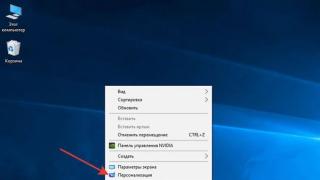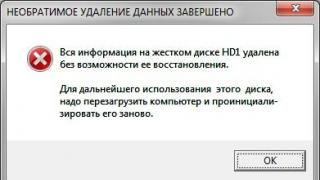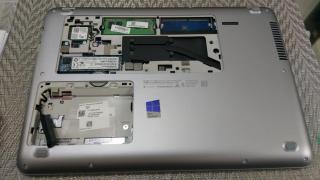Hello! New release software- it's not always good. It happens that fresh version firmware carries such errors, bugs, glitches (like), that you don’t want to install it. However, here the user has little choice - Apple did everything in its own way, and when fresh software is released, it is automatically-compulsorily downloaded to the device.
And not only does it eat free memory, it also signals with an annoying number “1” on the settings icon that it’s time to update the gadget. Yes, this can be explained by concern for users, because the newer the software, the better and safer it is (according to Apple developers). On the other hand, this is my device and I have to decide whether it can load something there itself (even if it's a firmware file) or not.
So, what to do if you don’t need such independence, you want to stay on the old iOS versions and you do not want to know about any updates ?! Now I'll tell you how to remove an already downloaded firmware and make sure that it no longer loads automatically. Let's go! :)
How to delete an already downloaded firmware file in iPhone and iPad
In order to get rid of the number 1 in the settings and delete the already downloaded firmware, you need to do the following:
- Go to settings and select "General".
- Then "Storage and iCloud usage" - "Manage".
- Find the downloaded firmware file and click "Uninstall update".
Just? Elementary! And there was more free space and the callus figure disappeared. Beauty... But unfortunately that's not all, because it will soon re-boot. But this can also be dealt with.
How to disable automatic download of a new version of iOS in iPhone and iPad
If you have a jail installed, then such issues are solved very simply - there are many tweaks that wean the gadget from amateur performance. But “hacking the device” just because of this is not very good idea, because Jailbreak ... Therefore, we will learn how to make sure that the firmware in the iPhone and iPad does not load on its own, without using a jailbreak.
As you know, Apple smartphones and tablets need Wi-Fi to download the firmware “over the air”. And rightly so, since the files are often very large in volume, and if they were downloaded via cellular networks- that would cost a lot of money.
It turns out that our task is to make sure that Wi-Fi does not see the Apple update server. To do this, in the router settings, you need to block two addresses - here they are:
- appldnld.apple.com
- mesu.apple.com
Please note that these two addresses are solely responsible for checking for updates - all other functions will work as they should.
After access to them is closed, through this wifi network The iOS device will not be able to check for updates on its servers, which means it will always think that you have the latest version of the software, and accordingly, there are no more automatically downloaded firmware and annoying units in the settings calling for an update.
Now, when charging a device with Wi-Fi enabled, only backup and all. And if you still want to update later, you can always remove these addresses from the blocked ones or just find another Wi-Fi network.
Updated! As I was quite rightly asked in the comments - what will happen if the iPhone or iPad checks for an update via the mobile Internet?
After all, block the server on the operator's side cellular communication impossible!
For such cases, there is another way to prevent the iPhone or iPad from updating - through the configuration profile:
- What should be done? Just install an Apple TV software profile on your device.
- What for? The iPhone or iPad will look for a suitable update for itself, but since the profile from Apple TV is installed, they will not be able to find it. That will save you from the annoying requirement to update iOS.
- Where to get it? Download the latest Apple TV configuration profile for iPhone and iPad
One of iOS benefits is an constant output updates applicable to most devices. The gadget itself checks for availability new version firmware and then downloads it "over the air". This allows the device to update without the hassle of connecting to a computer, working with iTunes.
In contact with
But sometimes this process does not start at the right time. Unfortunately, Apple company did not provide a button to cancel the firmware download. This problem has a solution.
Most often on the Internet, it is advised to simply turn off the Internet, thus interrupting the download of the update. That's just reconnection to the Web will resume the process. A reliable solution would be to uninstall the update altogether.
If for any reason you do not wish to install another iOS update on your iPhone or iPad (for example, iOS 12 on iPhone 5s or beta version of iOS) and the “red circle with a one” is no longer an eyesore, then be sure to check if the update itself has already been downloaded to the device and takes up a lot of space. How to remove it?
On iPhone and iPad with installed iOS 10 and up
1. Open the app Settings and follow the path Main → iPhone storage → storage.

2. Scroll down a bit and select the downloaded iOS update.
3. Click "Uninstall update".

4. Confirm the deletion.

On iPhone and iPad with iOS 8 installed
1 . Go to Settings → Main → Statistics → storage → Storage.

2 . Select the downloaded iOS update. Due to the fact that the file size is usually more than 1 GB, it is most likely to be located at the top of the list.

3 . Click " Removing an update» and again « Removing an update' to confirm the requested action.

Just a few simple actions, and the downloaded iOS update that takes up more than 1 GB will be deleted from your mobile device.
If necessary, you can restart the firmware update process. To do this, in the menu "Settings" → "Basic" → "Software Update" click on the button "Download and install".
06/07/2017, Wed, 16:17, Moscow, Text: Valeria Shmyrova
iOS 11 introduced the automatic removal of rarely used applications to clear memory. User files are saved. A deleted application can be restored by clicking on its icon, which remains on the desktop, just darkens.
Offload Unused Apps
AT iOS betas 11 for developers, there is a feature that removes applications rarely used by the user in case of insufficient memory on the device. The option is called Offload Unused Apps. When deleting an app, Offload saves all the user's files associated with it. The application icon on the desktop turns gray. To reinstall it, just click on it.
In iOS 10, the situation was different: in the event of a lack of memory, the system recommended to the user which application can be deleted and then restored, but never did this itself. Along with the application, the user's files were also deleted. As for iOS 11, it also retains more trivial ways to clear memory - for example, transferring data to iCloud. Also added another new option – automatic deletion conversations from a year ago in Messages.
How it works
Offload can be found and activated by going to Settings > General > iPhone Storage. Before iPhone section Storage was called Storage & iCloud Usage. AT active state Offload automatically runs in the background. The function selects the least used applications, but the user can also specify which program he would like to remove to clear space.
In iPhone Storage, you can activate Offload, but you cannot turn it off there. To do this, you have to go to Settings, then to iTunes & App Store s and scroll to the bottom of the list to see Offload Unused Apps. To deactivate, just click on the green indicator next to it.
Tom Moss(Tom Moss), founder of Android smartphone company Nextbit, took to Twitter to say that the Offload idea is not new. In particular, this concept was implemented in the Robin smartphone, which his company introduced in 2016. Even the icons remote applications in Robin also became gray.
Turning off automatic deletion of apps in iOS 11 is harder than turning it on
In defense of Offload, it should be noted that Apple has implemented in iOS capability temporarily remove applications back in 2015, but for a different reason. iOS 9 removed apps so that the iOS 8 device had enough memory to update, after which the apps were installed back. All user data is saved.
Other Features of iOS 11
operating room iOS system 11 was introduced at the Apple Worldwide Developers Conference (WWDC) 2017. So far, it exists only in beta, and only members have access to it. iOS programs developer program. To end of the month Apple plans to release a public beta version, and the company will begin deploying the final version on devices in the fall.
Of the significant innovations in iOS 11, augmented reality tools should be noted. For developers who want to develop this direction, the ARKit toolkit has been released. The CoreML package has appeared, which is responsible for machine learning.
As for applications, iOS 11 has a full-fledged file manager called "Files", marking Apple in this area. Apple Pay can now be used for translations using Messages or Siri.
Automatic activation of the Do Not Disturb option while driving has been added. The user can set a list of contacts who will receive a notification that he is currently driving. The navigator is now able to suggest a suitable road lane for making a turn.
A cool new feature in iOS 11.
The number of ways that allow has increased markedly with the advent of . In this guide, we have covered the most efficient way freeing up space on the iPhone, which appeared in . It will be about the "Download program" function.
Step 1. Go to the menu " Settings» → « iTunes Store and App Store».
Step 2. At the very bottom of the page, activate the switch " Download unused».

This new iOS 11 feature allows the system to automatic mode remove applications that are rarely used on the iPhone, and do it in a special way. iOS 11 will remove the app, but leave all the data and documents it uses on the device. Moreover, on the main iPhone screen the application icon will remain. The downloaded application will be marked special badge, the same one that can be seen in the App Store on the pages of applications previously installed on the iPhone.

When you click on the icon of a downloaded application, it will be downloaded from the App Store and will become available for use exactly in the state in which it was before it was deleted from the device.

How to manually download certain apps
Step 1. Go to the menu " Settings» → « Main» → « iPhone storage” and scroll down the page that opens to the list of applications installed on iPhone.

Step 2. Select the application (or game) that you want to remove from iPhone, while leaving all its data and documents on the device.
Step 3. Click " Download program» and confirm the action. On the application page, you can see the size of the application and the documents and data it is using.

In this simple way, you can temporarily download any application or game without waiting for iOS 11 to do it. This function opens up an excellent opportunity at any time to remove any heavy application from the iPhone in order to occupy the freed memory with other content. For example, if you are on vacation and shooting video on your iPhone, and the memory has come to an end, thanks to the new iOS features 11 you can painlessly free up space on your device.
How to remove the iOS 11 update if you decide that for normal operation iPhone has enough options previous version? Removing the update before installation on the phone and rollback after installation.
Deleting the firmware file
First, let's figure out how to remove uninstalled update iOS 11, which is already downloaded to the phone. The update will be downloaded only after you confirm your desire to install it. The firmware file is then stored in the device's memory until you run the installation new system. All this time, on the icon of the "Settings" application, a unity will light up, signaling the need to make changes to the configuration.
If you want to upgrade to the new version, go to the "Software Update" section in the "General" settings submenu, and click "Download and Install". After downloading the firmware file, two options will appear in the same section: "Install" and "Later" (start the installation at night or remind later). If you click "Install", then you will have to restore the device to remove iOS 11. If you click "Later" and select "Remind me later", you can easily delete the firmware from the iPhone memory.
To remove the downloaded firmware:
- Open settings.
- Select the "Basic" submenu.
- Go to the "Storage and iCloud usage" section, click "Manage".
- Find the downloaded file and tap "Uninstall update".

Done, the update is deleted, the system will not be updated. But this is only temporary peace: the next time you connect to WiFi iOS will again signal the presence of an update. You can completely ignore updates only after they are banned.
Device recovery
If the user has already updated the system, then no deletion of the firmware file will help - it is already installed. On iPhone 5S and other models, this can cause annoying crashes and errors. Users report that after installing the update, the touchscreen does not work for them, they do not connect WiFi devices and Bluetooth, battery problems occur.
To return your phone or tablet to operational state, you need to remove the update and roll back to the previous one stable version iOS. This can only be done in recovery mode via iTunes.
Before restoring the device, do not forget to do backup data.
- Download the appropriate version of iOS 10.3.3.
- Launch iTunes on your computer.
- Turn off the device.
- Clamp home button. While holding it, connect your phone to the computer (on the iPhone 7, you need to hold the power and volume down buttons).
- Wait until the connect screen appears in iTunes.
- Hold Shift on your keyboard (Alt/Option on Mac) and click Restore.
- Select the file you downloaded earlier iOS firmware 10.3.3.
- Click "Restore and Update".

You are again on the usual tenth iOS, but this will not save you from notifications about updates. You can ignore them, or you can ban them - temporarily or permanently.
Refresh disabled
To prevent the device from searching for and downloading updates, add an Apple TV profile to it. In this case, the update server will change to tvOS and the device will not look for new versions of iOS. To do this:
- Launch Safari.
- Download the NOOTA.mobileconfig file through it (for example, from hikay.github.io/app).
- Select a device and save the profile in settings.
- Reboot the device as requested by the system.

To make sure that the method worked, go to the "Software Update" section and start searching for a new version of iOS. The phone/tablet will not find anything as it will connect to the tvOS servers. The badge about the availability of updates will be displayed in the settings, but you can also remove it - however, for this you will have to delve into system files through the iBackupBot program.

If you decide to get rid of the ban, then it will be easy to do: you just need to go to "Settings" - "General" - "Profiles" and delete account with tvOS10.
This is the easiest way to disable updates and does not require jailbreak or tweaks. If there is a jail on the phone / tablet, then the number of options for preventing the update increases, but breaking the system just for the sake of it is not worth it, especially considering the fact that you can disable the update simple addition profile from Apple TV.



